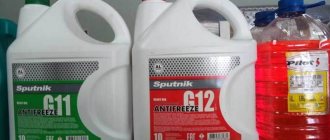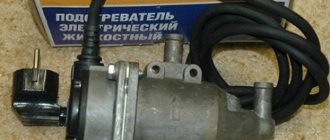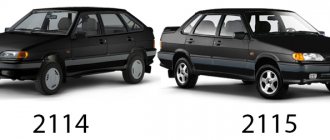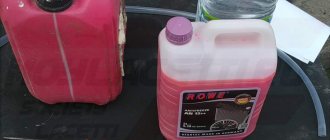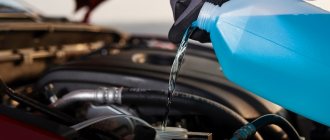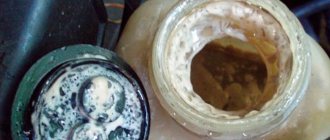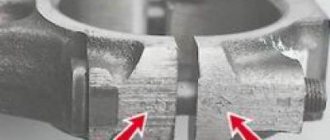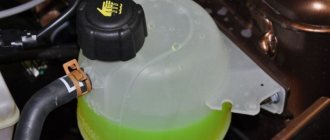Cars admin26.02.2020
The manufacturer AvtoVAZ recommends replacing the coolant at least once every two years or every 60,000 km. But it is possible that the antifreeze will need to be replaced earlier, if its composition has changed, it has changed in color, which may indicate poor quality and, as a result, corrosion in the channels of the cooling system. In order to replace antifreeze or antifreeze in the VAZ 2106 cooling system we will need:
- Wrench 13 regular or head with a knob
- Open-end wrench 12 (optional)
- Flat screwdriver
Procedure for draining coolant
First, you need to prepare a container for draining the antifreeze, preferably it should be at least 10 liters. First, you need to turn the heater (stove) control lever to the extreme right position, that is, at this moment the heater valve must be open completely so that the liquid from the heater radiator also drains.
Now you can start draining. Open the filler cap on the VAZ 2106 radiator:
After this, you can unscrew the plug from the cylinder block; it is located in the lower part on the left side of the engine. Its location is shown more clearly in the picture below:
And immediately place a container so that the old coolant drains into it. I used a couple of 1.5-liter bottles, alternately placing them in the hole:
When all the glass is here, you can turn off the tap in the lower left corner of the radiator:
If it does not turn away by hand, then you can use a key of the required size (12 in this case). After this, place a container under the hole and wait until all the liquid drains from the radiator:
As soon as all the liquid has been drained from the cooling system of the VAZ 2106, you can screw the plugs into the cylinder block and the radiator tap into place. And after that you can start replacing antifreeze (antifreeze).
First, pour liquid into the radiator until its level reaches the lower edge of the neck. Then we repeat the same with the expansion tank. To avoid the appearance of air locks in the cooling system, it is necessary to pour antifreeze in a thin stream. To prevent a plug from forming in the expansion tank hose, you need to raise the tank above the engine, having first removed it from the clamp:
Six system diagram
It must be said right away that it consists of two circuits - small and large. Look at the photo and pay attention to the arrows, they indicate in which direction the antifreeze is moving. 2106 is not the only model with a similar circuit; all classics have similar system designs. It is necessary to make a reservation: antifreeze and antifreeze are one and the same thing. In fact, antifreeze is a brand of antifreeze, and it differs from the one you are used to seeing only in the quantity and quality of additives. Tosol is a Soviet designation for antifreeze.
Thermostat operation at different antifreeze temperatures
If we go into detail and decipher the word “antifreeze”, then it can be literally translated – “against the cold”. It is a liquid that does not freeze. Vodka is also antifreeze. It just doesn’t contain the necessary additives. Well, okay, enough of the ranting, we still need to figure out what the cooling circuit of the VAZ 2106 consists of. So, let's start from the very beginning. You come to your car in the morning, sit behind the wheel and start the engine. At this moment, the liquid in the system begins to forcefully move in a small circle.
Pump 2106 makes the liquid move. Its price in stores is about 700 rubles. But this is only a cover with an impeller. We'll look at the detailed design below. Now your engine is running, warming up, and flashes occur in the combustion chambers. As a result, the surface of the cylinders heats up to a high temperature. But all the heat is transferred to the liquid, which flows through the engine cooling jacket.
And when it warms up to a temperature in the range of 80..85 degrees, the VAZ 2106 thermostat comes into operation, its price is around 400 rubles. It closes the circulation in the small circle and releases antifreeze in the large circle. A large cooling circle is the inclusion of one additional unit in the circuit - a radiator. It is worth mentioning that fluid circulates through the heater radiator constantly, regardless of the position of the thermostat valves.
Expansion tank six
And if antifreeze boils in the expansion tank of a VAZ 2106, then we can assume two breakdowns - failure of the thermostat or pump. In most cases, of course, the thermostat is to blame. This device is very delicate and fragile, and inside the cooling system there is usually so much debris that settles on the surface of the thermostat valves. And if it breaks, the liquid circulates in a small circle without getting into the cooling radiator. And here it doesn’t matter at all whether you are driving in a traffic jam or on the highway at normal speed. The antifreeze will still boil.
Coolant Application
- To maintain normal temperature (sensor) during engine operation.
- To maintain a low temperature (sensor) in the gearbox.
- For lubricating the water pump located in the engine.
- For heating the interior in winter cold.
Replacing antifreeze or antifreeze in a VAZ 2106 car should be done every 45 thousand km or once every two years, depending on the circumstances. Replacement must be made because this substance, like many others, loses its properties over time and succumbs to corrosion. In order to avoid this, you need to change it in time.
Principle of operation
The main place in a car is not the driver’s seat or even the steering wheel, but the engine. It is even called the heart. And this is not without reason, because the correct functioning of this heart directly determines whether the car will go or not. And in order not to destroy such an important technical unit, it is necessary to maintain a certain temperature and cool it in time.
The operating principle of this system is quite simple, but at the same time technically well thought out. It is connected by pipes to the engine itself, the radiator and the interior heater. To understand the importance of these elements, you need to know their main functions:
- Maintaining the required temperature.
- Engine cooling.
- Warming up the car interior.
In the first case, for engine operation and proper combustion of the fuel mixture, a certain and stable temperature is required. If it is higher or lower, it has a very bad effect on the engine. In the second case, the engine is protected from overheating, which can lead to deformation of some parts inside.
If you exclude the last item from the list, then operating the car will become impossible in cold weather. And a key role in this system is played by a special liquid, without which the presence of a cooling cycle would be meaningless.
Types of coolants
To absorb heat and remove it from hot spots in the engine, the system requires coolant. There are several types of cooling liquids:
- Water.
- Antifreeze.
- Antifreeze.
But in the harsh realities of the Russian climate, the use of water as a coolant is impractical. And it boils away very quickly, having a rather low thermal conductivity. You don’t even need to mention how it affects the occurrence of corrosion.
Antifreeze is the most common among domestic car owners, but it has some disadvantages, for example, the formation of an oil film inside the vessels and pipes, which prevents normal heat transfer. Accordingly, heat removal becomes ineffective.
The third option has more pros than cons. Firstly, antifreeze begins to crystallize at very low temperatures, that is, it does not freeze, which is why it got its name. This advantage allows the use of antifreeze even in the Far North. Secondly, the thickness of the oil film formed inside the vessels is very small, thanks to which almost nothing interferes with the transfer of heat. This is achieved due to the fact that antifreeze, unlike antifreeze, is made from organic components.
The main disadvantage of antifreeze is its price, especially if you need to replace the entire fluid. Antifreeze wins here, and it is more rational to use it in car models such as the VAZ-2101 or VAZ-2106. In models of the domestic automobile industry with impressive age and mileage, the cooling system often becomes a sore and vulnerable spot. Therefore, the owners of these cars need to know the principle of operation of the cooler and understand how to repair it, which will help avoid spending on services and auto repairmen.
How to change coolant
Before replacing the coolant, you need to figure out how to fill it correctly, where, what quantity is needed and what brand. The draining and filling of this substance occurs in the expansion tank, which is located in the engine compartment on the left side of the mudguard on a bracket and secured with clamps.
Temperature sensor locations
You will need a volume of 10 liters of antifreeze or antifreeze. Which is better for you? According to reviews, the first one slightly exceeds the indicators; it is also sold in a ready-made form, or it needs to be diluted in a simple proportion (50 to 50). Choose a high-quality and reliable brand.
Before replacing, do not forget to check the temperature gauge (sensor). It is the first criterion that signals immediate replacement. If the temperature is above normal, then start measuring the level. For this:
- Unfasten the rubber strap.
- Unscrew the tank cap and look at the mark (it should be 3-4 mm higher than “min”).
Video “Draining the coolant”
This video shows how coolant is drained on a VAZ 2106.
Coolant regulates many important processes in a car. For example, it cools the motor, it affects the temperature sensor and its indicators (during normal operation, the indicator should be at a low level). And in order to maintain all these processes normally, the VAZ 2106 antifreeze must be replaced on time.
How many liters do you need
9 liters, with expansion tank 10 liters.
How to drain
Stage one - draining the antifreeze from the radiator.
You need to unscrew the plug that covers the radiator neck (antifreeze is poured through it) and place a container under the radiator. In its lower part there is a drain plug, which should be unscrewed slowly (so that drops of antifreeze do not fall on the car components). If a VAZ 2106 is an early model and has an old radiator, it is impossible to find such a plug (because it does not exist). But there is a special sensor that activates the fan. This is what needs to be unscrewed with a 30 mm wrench.
Stage two - draining antifreeze from the engine block
To gain access to the drain plug located on the power unit block, you need to remove the ignition module. The plug is unscrewed using a 13 mm wrench. At the end of the draining, carefully tighten the plugs and wipe the car components with a rag, and also release excess air from the cooling system. This is done quite simply - the clamp clamp is loosened with a screwdriver, and the rubber hose is removed from the intake manifold.
How to fill
Before you start draining the old coolant, you need to move the heating valve control lever inside the car to the extreme right position (the valve is open). Unscrew the expansion tank cap and the radiator filler cap.
In the lower left corner of the radiator we find the drain plug, unscrew it and drain the liquid into a previously prepared container. On old-style radiators there is no such plug. Instead, using a 30 key, you will have to unscrew the fan switch sensor. Also on the engine block, we find it and use a 13 key to unscrew the drain plug. After the liquid has been drained, screw the drain plugs into place.
And in order to avoid the formation of an air lock in the system, use a screwdriver to loosen the clamp and remove the rubber hose from the intake manifold fitting. That's it, you can fill in antifreeze. As soon as liquid begins to flow out of the fitting, you can put a hose on it and tighten the clamp. Afterwards, completely fill the radiator and tighten the cap. Next, pour antifreeze into the expansion tank, the optimal level is 3-4 cm above the MIN mark. We start the engine and warm it up to operating temperature.
After that, turn off the engine and check the coolant level again. If necessary, add antifreeze. If the car's cooling system is dirty, it should be washed with water or special products.
The flushing procedure is the same as when replacing the fluid: drain, fill and dilute, start the engine for a few minutes and drain. And so on several times until you see clean water flowing from the radiator and engine block.
How to change
Procedure for replacing coolant:
1. Before you start draining the old coolant, you need to move the heating valve control lever inside the car to the extreme right position (the valve is open).
2. Unscrew the expansion tank cap and the radiator filler cap.
3. In the lower left corner of the radiator we find the drain plug, unscrew it and drain the liquid into a previously prepared container.
On old-style radiators there is no such plug. Instead, using the key set to “30”, you will have to unscrew the fan switch sensor.
4. Also on the engine block, we find it and use the key to “13” to unscrew the drain plug.
5. After the liquid has been drained, screw the drain plugs into place. And in order to avoid the formation of an air lock in the system, use a screwdriver to loosen the clamp and remove the rubber hose from the intake manifold fitting.
6. That's it, you can fill in antifreeze. As soon as liquid begins to flow out of the fitting, you can put a hose on it and tighten the clamp. Afterwards, completely fill the radiator and tighten the cap. Next, pour antifreeze into the expansion tank, the optimal level is 3-4 cm above the “MIN” mark.
7. Start the engine and warm it up to operating temperature. After that, turn off the engine and check the coolant level again. If necessary, add antifreeze.
If the car's cooling system is dirty, it should be washed with water or special products. The flushing procedure is the same as when replacing the fluid - drain, fill and dilute, start the engine for a few minutes and drain. And so on several times until you see clean water flowing from the radiator and engine block.
Drain
To get started, make sure you have all the necessary tools:
- key or head;
- screwdriver;
- container for draining;
- stock of new coolant.
Removing the radiator cap
If your engine is cool, you can start working right away.
- Park the car on a level road.
- Open the hood and remove the radiator cap.
- Unscrew the cap from the tank.
- Place a container for draining (one that can hold at least 5 liters).
- Unscrew the bolt and also the radiator cap. Now you can drain everything.
Fill in
If the first part of the procedure was successful, then you can safely proceed to the second.
- Tighten the bolt.
- Fill the radiator with the required amount of antifreeze or antifreeze.
- Remove the hose and let the substance flow into it so that it flows out the other side. Lift the tank, insert the hose and pour in completely.
- Turn on the engine before the fan starts.
- Turn it off and check the sensor and level.
- Now tighten the radiator cap and tank cap. Screw on the cap and close the hood.
Done, the replacement in the VAZ 2106 was completed successfully.
Pour liquid into a special hole
Cooling system VAZ 2107: device and diagram
Movement is life, but movement is warmth. Try rubbing your palms together and see for yourself. Heat is the final transformation of all energies into each other. In the human body, mutual transformations of proteins, fats, and carbohydrates occur, which as a result decompose through multi-stage enzymatic oxidation with the release of heat.
In the heart of a car engine, chemical transformations of fuel into exhaust gases and water also occur, releasing a large amount of energy, which is converted into mechanical energy, and some is dissipated as heat. Moreover, this heat must be purposefully collected and removed, no matter how much of it is generated.
This is precisely what the cooling system of the VAZ 2107 serves for.
If we remember that the efficiency of a gasoline engine is ideally 25%, and in city traffic jams - about 7%, this means that out of a 40 liters of a fully filled VAZ 2107 tank in city conditions, you spent only three liters on moving the car! How many? We repeat, three liters, we were not mistaken. Where did the other thirty-seven go? That's right, they burned in a useless fire, polluting the air and wearing out the car. The carburetor and injector improve efficiency, but not much. The cooling system of the VAZ 2107 is responsible for removing this heat.
The engine cooling system diagram is as follows:
Structure of the main parts of the system: (in the picture there is a VAZ 2106 engine on which a carburetor is installed).
- The actual jacket of the engine cooling system (7), passages and holes in the cylinder block, with its exhaust pipe (4).
- The cooling system pump, or pump (16), during the operation of which coolant (antifreeze, antifreeze) circulates. Its structure is similar to an impeller. It is in a single connection with the generator, a single belt (15).
- Thermostat (18) separates the small (when the engine is cold) and large (when the engine is hot) fluid circulation circles. The thermostat device is simple; its task is to open or close the liquid bypass valve.
- Cooling system hoses (discharging cooled liquid from the radiator and supplying hot liquid to the radiator, thermostat hoses, hoses to the pump, etc.).
- The radiator is the main heat exchanger with a cooling function. The design of the radiator can be different; now aluminum is used, but a copper radiator is much more efficient, but less resistant.
- Radiator fan, commonly known as “Carlson” (11), which turns on if necessary when the engine temperature rises.
- Expansion tank available for visual control of fluid quality and topping up. A durable hose runs from the expansion tank to the radiator neck. Some people think it's a coolant hose, but that's wrong. Its function is simply to keep the radiator filled.
A complete cooling system diagram includes additional parts such as drain plugs, fan switch, fan fuse, and others.
Let us remind you that on the VAZ 2107 the electrical circuit is such that the fan and sound signal fuse is one common, 10 A.
This means that if you beep too much when the fan is running (and this can be easily noticed by the slight noise and increased charge consumption), you risk being left with an overheated engine.
The total volume of the cooling system on the VAZ 2107 is 9.85 liters. Inexperienced drivers sometimes find it impossible to fill more than 3-5 liters; this is hampered by air pockets that need to be removed. The volume of plugs can be half the volume of the entire system! The container is designed for a completely filled jacket, hoses, radiator, and expansion tank.
In the cooling system, the freezing point of antifreeze should not be higher than -40 degrees Celsius.
People often ask: injector and carburetor - is there a difference in the cooling system? Yes, there is, but it is insignificant.
Why does it flow
If the lubricant level in your VAZ 2106 car begins to decrease, then there is a high probability that a leak has occurred and before changing it, you need to “patch” the leak site. Finding it is sometimes not very easy. Try searching in places like:
- clamps (it is possible that they are not clamped well);
- radiator (mechanical damage);
- pump (pump worn out);
- leakage from under the head;
- leak into the cabin.
In some cases, you will have to replace the part, in others you will just have to screw it in, seal it and weld it, but there are also cases when the matter requires serious repairs and you will have to take the car to a service center. Therefore, pay close attention to your car and monitor the level and temperature.
When to replace antifreeze
There are several general rules about updating the engine coolant, which help determine when exactly it is necessary to fill the VAZ tank with antifreeze:
- The car's mileage reached 60 thousand km;
- the machine ran on the same fluid for two years;
- change in color (mostly red).
Correct update sequence
It is important to know that to replace the coolant in a VAZ 2106 car you need to clearly and carefully perform a number of actions
. If one point is missed, the replacement will not only be useless, but can also lead to unwanted damage.
The amount of antifreeze in a VAZ 2106
Today we will talk about coolant - antifreeze and antifreeze. Many will think that this topic is more appropriate in the summer season, because in winter it is more difficult to warm up the engine than to cool it down. This is wrong. The engine can boil even in winter; you can also defrost the cooling system.
An inexperienced driver can expect several more dangers, and we will talk about them. The basis of any coolant is ethylene glycol, which prevents the system from defrosting, although it is diluted with water.
The main nuances of antifreeze
The main advantage of this mixture is good heat dissipation and high boiling point. There is also a drawback - ethylene glycol is very aggressive towards metal. In order to prevent corrosion, special additives are added to the mixture. So, antifreeze coolant consists of 53% ethylene glycol, 45% distilled water, and 2% additives.
Remember, in no case should you add ordinary water to the antifreeze, it destroys the protective properties of the additives and corrosion from this mixture is many times more active than from plain water, first of all the heart of the cooling system - the pump - suffers. If you add it, then only distilled water, but in the fall you will have to replace the coolant, because diluted antifreeze can freeze.
How to do a wheel alignment on a VAZ 2114
Foreign antifreezes, on the contrary, must be diluted with water. Because Western manufacturers produce a concentrate that is diluted with water in the proportions required by the buyer. On the antifreeze packaging itself there must be instructions with the necessary information.
It is the additives that affect the freezing and boiling points of the coolant. Violation of the percentage of additives in antifreeze can lead to major troubles. If, after overheating, the engine is still subject to repair, then after defrosting the system, you simply throw it away.
Antifreeze was developed in the USSR and replaced antifreeze quite recently - about thirty years ago. Antifreeze and antifreeze have the same base - ethylene glycol. Antifreeze comes in bright blue, red-brown and blue-green colors. Color does not play any role, since dyes are added arbitrarily.
When to change antifreeze?
You need to know the following. When to change antifreeze coolant? Coolant service life is 2 years or 30,000 km. mileage, but many car owners manage to drive on one antifreeze for 6 years. It is very dangerous.
Over time, antifreeze changes its characteristics - heat transfer decreases, water evaporates, and additives cease to perform their anti-corrosion function. Determining the wear time of antifreeze is very simple. A normal solution is slippery to the touch, oily, with its inherent bright color. If the antifreeze has become liquid and its color is brown or red, change the coolant immediately.
The density of antifreeze is measured with a hydrometer (standard 1.065-1.085 g/cm3). If these numbers don’t tell you anything, then buy antifreeze only in trusted stores. Remember, saving is not appropriate here; you don’t need to spare 100 rubles and then pay thousands for repairs.
When purchasing antifreeze, do not forget to ask the seller for a means to clean the cooling system. You will need it when replacing the coolant. This solution perfectly cleanses the system of rust and scale.
If you are going to change antifreeze at a service station, then remember, after draining the old fluid, you must flush the cooling system; this process will take about 1 hour.
Is it possible to mix antifreezes?
Antifreeze coolants come in different brands - Tosol-AM (concentrate), Tosol-A65M, Tosol-A40M. The numbers indicate freezing temperature.
Is it possible to mix different brands of antifreeze? It is possible, but not advisable, since mixing different additives can disrupt the protective film, which will lead to corrosion and the formation of sediment.
If you do add another brand of antifreeze to the system, then it is not recommended to drive it for a long time; at the first opportunity, replace the antifreeze with a new one.
Video - using antifreeze:
Whether you fill your car with antifreeze or antifreeze is up to you. Good luck!
Painting Prior door trims
( 1 time, rating: 5.00 out of 5)
To drain old fluid
First, let's look at how to drain antifreeze from a VAZ 2106, which no longer copes with the cooling function of the system. You need to start by removing the crankcase protection and moving the warm air supply lever to the right side. The next step is to remove the radiator filler cap. Next, you need to remove the fluid drain plug located on the surface of the cylinders. Now you can safely pour the antifreeze into the previously prepared tank.
How to drain and replace antifreeze on a VAZ?
Replacing antifreeze in the engine cooling system is an event that is performed at certain intervals in order to maintain efficient operation of the cooling system. Today you will learn how to drain and change antifreeze on a VAZ 2107 and why this is done.
Why do they change antifreeze?
The cooling system of many modern cars is liquid.
That is, heat transfer is carried out by a liquid that circulates through a system of tubes and, cooling in the radiator, returns back to the engine to receive a new portion of heat.
The VAZ 2107 engine cooling system initially used water, but later, due to reduced resistance to negative temperatures, it was replaced with antifreeze.
Antifreeze, compared to water, has good resistance to frost and does not freeze at all. In addition, it is not a source of scale, which means it does not clog the cooling system.
In the process of constant temperature exposure, antifreeze may lose its properties. That is, first of all, its boiling point decreases and becomes equal to the boiling point of ordinary water.
Secondly, such fluid can easily freeze and cause a cracked reservoir, and in the worst case, a cracked cylinder block.
That is why antifreeze must be changed at least once every six months during seasonal vehicle maintenance in order to avoid undesirable consequences.
How to drain antifreeze correctly?
In order to drain the antifreeze, it is not enough to simply turn off the taps. To begin with, you need to understand that antifreeze is a toxic substance, which means it can pose a danger to humans if handled incorrectly. In this regard, there are a number of rules that must be followed:
- Under no circumstances should you drain antifreeze onto the floor in your garage or yard . Since this substance is toxic, its fumes can enter the human respiratory system. Do not underestimate the chemical composition of antifreeze. After all, one glass of such “muck” can easily kill a person.
- As you already understand, you should not allow antifreeze to get into your mouth. Many drivers do a very dangerous test when determining the type of liquid poured into the expansion tank: they dip their finger into this tank and then try it with their tongue. If it was sweet, then it is 100% antifreeze, and if not, and it gives off scale, then it is the most ordinary water, which has already been overheated more than once.
- If antifreeze gets into your eyes, hands or other parts of the body, be sure to rinse these areas under running cold water and call a specialist doctor. Do not forget that antifreeze is, first of all, poison for humans, and only then a coolant for the engine.
- After completing work related to repairing the cooling system, you must thoroughly wash your hands. In addition, it is strictly prohibited to eat anything while performing this work.
To properly drain the antifreeze, you need to prepare an empty container with a capacity of at least 10 liters. The most desirable condition is the presence of a wide cavity and not a deep bottom. The fact is that there is not enough space under the car in height, but there is enough width. That is why many drivers use the most ordinary aluminum trough for these purposes.
To fill in a new substance
In order to replace the antifreeze with a new one, you need to return the radiator tank to its original place and tighten the drain plugs and the neck of the part. After this, new coolant should be poured into the radiator and its expansion tank, but slightly more than the minimum mark. An equally important action is to neutralize all air pockets formed in the cooling system.
After closing the radiator, you can start the car and let it idle for about five minutes. After the engine has cooled down, it is necessary to add antifreeze to the maximum level.
.
Procedure for replacing antifreeze
Coolant replacement steps:
Check the sensor, which is responsible for the qualitative and quantitative indicators of antifreeze in the system.
Drain off any remaining old antifreeze. To do this, you need a container into which the waste material will drain.
Make sure that the engine has completely cooled down, because if this does not happen, you can easily get a serious burn.
Place the car on a slope to better drain all unnecessary liquid.
Unscrew the plugs and bolts from the radiator and expansion tank.
Be sure to rinse the entire system several times with water or special products. This is primarily necessary when you want to use another type of cooler.
Fill with new antifreeze and turn on the engine. Let it work for a while.
If possible, check the selected fluid against the vehicle manufacturer's specifications and service intervals.
Is it possible to fill
Very often, car enthusiasts do not pay due attention to the coolant in the engine cooling system, and in most cases, not only do they not change the coolant at all, but they do not even know what exactly is poured into the engine cooling system of their car. Such carelessness is in vain. After all, further maintenance of the entire vehicle depends on the correct choice between antifreeze and antifreeze. And so, let's figure out which is better - antifreeze or antifreeze.
This division of coolants into antifreeze and antifreeze exists only in Russia. The origin and history of TOSOL have already been repeatedly described in various media. According to Arteco, up to 22% of all breakdowns are directly, and 40% are directly or indirectly related to the engine cooling system. Therefore, paying proper attention to cooling and choosing the right coolant can help save money and time.
The composition of lubricating coolants includes mixtures of ethylene glycol (occasionally containing mixtures of propylene glycol), water and a whole package of corrosion inhibitor additives. Coolants from different manufacturers differ from each other precisely in the production technology of the additives included in their composition.
When choosing a lubricating coolant for your car, first of all you need to study its operating manual or service book to find out the recommendations of the car manufacturer and possible nuances of using a particular fluid known to the latter. In such a manual, the automaker can prescribe specific manufacturers and names of cutting fluids that have successfully passed all tests and tests (laboratory, bench, operational) conducted by the automaker, or prescribe the class of such fluids. These include liquids produced using one of the following technologies:
traditional - the composition includes additive packages based on salts of inorganic acids (nitrates, nitrites, borates, silicates, phosphates, amines);
carboxylate (OAT) – the composition includes additive packages based on salts of organic acids (carbonates);
hybrid – a type of carboxylate technology in which additive packages are created based on salts of carboxylic acids with minor additions of silicates and/or phosphates).
The Russian market is dominated by cutting fluids produced using traditional (antifreeze) and carboxylate (antifreeze) technologies.
